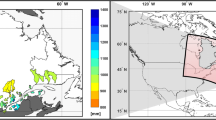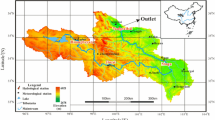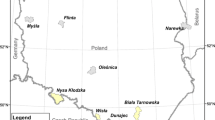Abstract
Climate change projections suggest that extremes, such as floods, will modify their behaviour in the future. Detailed catchment-scale studies are needed to implement the European Union Floods Directive and give recommendations for flood management and design of hydraulic infrastructure. In this study, a methodology to quantify changes in future flood magnitude and seasonality due to climate change at a catchment scale is proposed. Projections of 24 global climate models are used, with 10 being downscaled by the Spanish Meteorological Agency (Agencia Estatal de Meteorología, AEMET) and 14 from the EURO-CORDEX project, under two representative concentration pathways (RCPs) 4.5 and 8.5, from the Fifth Assessment Report provided by the Intergovernmental Panel on Climate Change. Downscaled climate models provided by the AEMET were corrected in terms of bias. The HBV rainfall-runoff model was selected to simulate the catchment hydrological behaviour. Simulations were analysed through both annual maximum and peaks-over-threshold (POT) series. The results show a decrease in the magnitude of extreme floods for the climate model projections downscaled by the AEMET. However, results for the climate model projections downscaled by EURO-CORDEX show differing trends, depending on the RCP. A small decrease in the flood magnitude was noticed for the RCP 4.5, while an increase was found for the RCP 8.5. Regarding the monthly seasonality analysis performed by using the POT series, a delay in the flood timing from late-autumn to late-winter is identified supporting the findings of recent studies performed with observed data in recent decades.











Similar content being viewed by others
References
Alfieri L, Burek P, Feyen L, Forzieri G (2015) Global warming increases the frequency of river floods in Europe. Hydrol Earth Syst Sci 19:2247–2260. https://doi.org/10.5194/hess-19-2247-2015
Álvarez AJ, Mediero L, García C (2014) Review and selection of statistical models to fit maximum annual peak flows distribution function in Spain. Ing Civ 174:5–31
Athira P, Sudheer KP, Cibin R, Chaubery L (2016) Predictions in ungauged basins: an approach for regionalization of hydrological models considering the probability distribution of model parameters. Stoch Environ Res Risk Assess 30:1131–1149. https://doi.org/10.1007/s00477-015-1190-6
Bergström S (1992) The HBV model—its structure and applications. SHMI Reports RH, No 4, Norrköping, Sweden
Bergström S (1995) The HBV model. In: Singh VP (ed) Computer models of watershed hydrology. Water Resources Publications, Colorado, USA, pp 443–476
Blöschl G, Hall J, Parajka J, Perdigao RAP, Merz B, Arheimer B, Aronica GT, Bilibashi A, Bonacci O, Borga M, Canjevac I, Castellarin A, Chirico GB, Claps P, Fiala K, Frolova N, Gorbachova L, Gul A, Hannaford J, Harrigan S, Kireeva M, Kiss A, Kjeldsen TR, Kohnova S, Koskela JJ, Ledvinka O, Macdonald N, Mavrova-Guirguinova M, Mediero L, Merz R, Molnar P, Montanari A, Murphy C, Osuch M, Ovcharuk V, Radevski I, Rogger M, Salinas JL, Sauquet E, Sraj M, Szolgay J, Viglione A, Volpi E, Wilson D, Zaimi K, Zivkovic N (2017) Changing climate shifts timing of European floods. Science 357:588–590. https://doi.org/10.1126/science.aan2506
Booij MJ (2005) Impact of climate change on river flooding assessed with different spatial model resolutions. J Hydrol 303:176–198. https://doi.org/10.1016/j.jhydrol.2004.07.013
Camici S, Brocca L, Melone F, Moramarco T (2014) Impact of climate change on flood frequency using different climate models and downscaling approaches. J Hydrol Eng 19:04014002. https://doi.org/10.1061/(ASCE)HE.1943-5584.0000959
Castiella J, Pérez-Martín C, Sanz-Azcárate L (2007) Documento Técnico para la Participación Pública en la Cuenca del Arga. Gobierno de Navarra, Pamplona, España. http://www.crana.org/themed/crana/files/docs/136/232/dossier_cuenca_arga.pdf. Accessed 14 Jan 2018
Daggupati P, Yen H, White MJ, Srinivasan R, Arnold JG, Keitzer CS, Sowa SP (2015) Impact of model development, calibration and validation decisions on hydrological simulations in West Lake Erie Basin. Hydrol Process 29:5307–5320. https://doi.org/10.1002/hyp.10536
Dobler C, Hagemann S, Wilby RL, Stotter J (2012) Quantifying different sources of uncertainty in hydrological projections in an Alpine watershed. Hydrol Earth Syst Sci 16:4343–4360. https://doi.org/10.5194/hess-16-4343-2012
Feldman AD (1995) HEC-1 flood hydrograph package. In: Singh VP (ed) Computer models of watershed hydrology. Water Resources Publications, Highland Ranch, pp 119–150
Flato G, Marotzke J, Abiodun B, Braconnot P, Chou SC, Collins W, Cox P, Driouech F, Emori S, Eyring V, Forest C, Gleckler P, Guilyardi E, Jakob C, Kattsov V, Reajson C, Rummukainen M (2013) Evaluation of Climate Models. In: Climate change 2013: the physical science basis. Contribution of Working Group I to the fifth assessment report of the intergovernmental panel on climate. Cambridge University Press, Cambridge
Giorgi F (2006) Climate changehot-spots. Geophys Res Lett 33:L08707. https://doi.org/10.1029/2006GL025734
Hirabayashi Y, Mahendran R, Koirala S, Konoshima L, Yamazaki D, Watanabe S, Kim H, Kanae S (2013) Global flood risk under climate change. Nat Clim Chang 3:816–821. https://doi.org/10.1038/nclimate1911
Hosking JRM, Wallis JR, Wood EF (1985) Estimation of the generalized extreme-value distribution by the method of probability-weighted moments. Technometrics 27:251–261
IPCC (2014) Climate change 2014: synthesis report Contribution of Working Groups I, II and III to the Fifth Assessment Report of the Intergovernmental Panel on Climate Change. IPCC, Geneva
Jacob D, Petersen J, Eggert B, Alias A, Christensen OB, Bouwer L, Braun A, Colette A, Déqué M, Georgievski G, Georgopoulou E, Gobiet A, Menut L, Nikulin G, Haensler A, Hempelmann N, Jones C, Keuler K, Kovats S, Kröner N, Kotlarski S, Kriegsmann A, Martin E, Meijgaard E, Moseley C, Pfeifer S, Preuschmann S, Radermacher C, Radtke K, Rechid D, Rounsevell M, Samuelsson P, Somot S, Soussana JF, Teichmann C, Valentini R, Vautard R, Weber B, Yiou P (2014) EURO-CORDEX: new high-resolution climate change projections for European impact research. Reg Environ Chang 14:563–578. https://doi.org/10.1007/s10113-013-0499-2
Kara F, Yucel I (2015) Climate change effects on extreme flows of water supply area in Istanbul: utility of regional climate models and downscaling method. Environ Monit Assess 187:580. https://doi.org/10.1007/s10661-015-4808-8
Knutti R, Furrer R, Tebaldi C, Cermak J, Meehl G (2010) Challenges in combining projections from multiple climate models. J Clim 23:2739–2758. https://doi.org/10.1175/2009JCLI3361.1
Kundzewicz ZW, Krysanova V, Dankers R, Hirabayashi Y, Kanae S, Hattermann FF, Huang S, Milly PCD, Stoffel M, Driessen PPJ, Matczak P, Quevauviller P, Schellnhuber H-J (2017) Differences in flood hazard projections in Europe—their causes and consequences for decision making. Hydrol Sci J 62:1–14. https://doi.org/10.1080/02626667.2016.1241398
Lang M, Ouarda TBMJ, Bobée B (1999) Towads operational guidelines for over-threshold modeling. J Hydrol 225:103–117. https://doi.org/10.1016/S0022-1694(99)00167-5
Lindström G, Johansson B, Persson M, Gardelin M, Bergström S (1997) Development and test of the distributed HBV-96 hydrological model. J Hydrol 201:272–288. https://doi.org/10.1016/S0022-1694(97)00041-3
Madsen H, Pearson CP, Rosbjerg D (1997) Comparison of annual maximum series and partial duration series methods for modelling extreme hydrologic events: 2. Regional modeling. Water Resour Res 33:759–769. https://doi.org/10.1029/96WR03849
Mediero L, Garrote L, Martín-Carrasco FJ (2011) Probabilistic calibration of a distributed hydrological model for flood forecasting. Hydrol Sci J 56:1129–1149. https://doi.org/10.1080/02626667.2011.610322
Mediero L, Santillan D, Garrote L, Granados A (2014) Detection and attribution of trends in magnitude, frequency and timing of floods in Spain. J Hydrol 517:1072–1088. https://doi.org/10.1016/j.jhydrol.2014.06.040
Mediero L, Kjeldsen TR, Macdonald N, Kohnova S, Merz B, Vorogushyn S, Wilson D, Alburquerque T, Blöschl G, Bogdanowicz E, Castellarin A, Hall J, Kobold M, Kriauciuniene J, Lang M, Madsen H, Onuşluel Gül G, Perdigão RAP, Roald LA, Salinas JL, Toumazis AD, Veijalainen N, Þórarinsson Óðinn (2015) Identification of coherent flood regions across Europe by using the longest streamflow records. J Hydrol 528:341–360. https://doi.org/10.1016/j.jhydrol.2015.06.016
Meresa HK, Romanowicz RJ (2017) The critical role of uncertainties in projections of hydrological extremes. Hydrol Earth Syst Sci 21:4245–4258. https://doi.org/10.5194/hess-21-4245-2017
Milly PCD, Betancourt J, Falkonmark M, Hirsch RM, Kundzewicz ZW, Lettenmaier DP, Stouffer RJ (2008) Stationarity is dead: whither water management? Science 319:573–574. https://doi.org/10.1126/science.1151915
Morata-Gasca A (2014) Guía de escenarios regionalizados de cambio climático sobre España a partir de los resultados del IPCC-AR4. Agencia Estatal de Meteorología, Ministerio de Agricultura, Alimentación y Medio Ambiente, Madrid
Moriasi DN, Arnold JG, Van Liew MW, Bingner RL, Harmel RD, Veith TL (2007) Model evaluation guidelines for systematic quantification of accuracy in watershed simulations. T ASABE 50:885–900
Nash JE, Sutcliffe JV (1970) River flow forecasting through conceptual models part I—a discussion of principles. J Hydrol 10:282–290. https://doi.org/10.1016/0022-1694(70)90255-6
Osuch M, Lawrence D, Meresa KH, Napiorkowski JJ, Romanowicz J (2017) Projected changes in flood indices in selected catchments in Poland in the 21st century. Stoch Environ Res Risk Assess 23:2435–2457. https://doi.org/10.1007/s00477-016-12965
Pechlivanidis IG, Arheimer B, Donnelly C, Hundecha Y, Huang S, Aich V, Samaniego L, Eisner S, Shi P (2017) Analysis of hydrological extremes at different hydro-climatic regimes under present and future conditions. Clim Chang 141:467–481. https://doi.org/10.1007/s10584-016-1723-0
Petrow T, Merz B (2009) Trends in flood magnitude, frequency and seasonality in Germany in the period 1951–2002. J Hydrol 371:129–141. https://doi.org/10.1016/j.jhydrol.2009.03.024
Piani C, Weedon GP, Best M, Gomes SM, Viterbo P, Hagermann S, Haerter JO (2010) Statistical bias of global simulated daily precipitation and temperature for the application of hydrological models. J Hydrol 395:199–215. https://doi.org/10.1016/j.hydrol.2010.10.024
Piras M, Mascaro G, Deidda R, Vivoni ER (2014) Quantification of hydrologic impacts of climate change in a Mediterranean basin in Sardinia, Italy, through high-resolution simulations. Hydrol Earth Syst Sci 18:5201–5217. https://doi.org/10.5194/hess-18-5201-2014
Piras M, Mascaro G, Deidda R, Vivoni ER (2016) Impacts of climate change on precipitation and discharge extremes through the use of statistical downscaling approaches in a Mediterranean basin. Sci Total Environ 543:952–964. https://doi.org/10.1016/j.scitotenv.2015.06.088
Ribalaygua J, Rosa M, Portoles J, Roldan E, Gaitan E, Chinarro D, Torres L (2013) Climate change scenarios for temperature and precipitation in Aragon (Spain). Sci Total Environ 463:1015–1030. https://doi.org/10.1016/j.scitotenv.2013.06.089
Rojas R, Feyen L, Dosio A, Bavera D (2011) Improving pan-European hydrological simulation of extreme events through statistical bias correction of RCM-driven climate simulations. Hydrol Earth Syst Sci 15:2599–2620. https://doi.org/10.5194/hess-15-2599-2011
Rojas R, Feyen L, Bianchi A, Dosio A (2012) Assessment of future flood hazard in Europe using a large ensemble of bias-corrected regional climate simulations. J Geophys Res Atmos 117:D17109. https://doi.org/10.1029/2012JD017461
Seibert J (1999) Regionalisation of parameters for a conceptual rainfall-runoff model. Agric Forest Meteorol 98:279–293. https://doi.org/10.1016/S0168-1923(99)00105-7
Seibert J, Vis M (2012) Teaching hydrological modeling with a user-friendly catchment-runoff-model software package. Hydrol Earth Syst Sci 16:3315–3325. https://doi.org/10.5194/hess-16-3315-2012
Sunyer MA, Madsen H, Ang PH (2012) A comparison of different regional climate models and statistical downscaling methods for extreme rainfall estimation under climate change. Atmos Res 103:119–128. https://doi.org/10.1016/j.atmosres.2011.06.011
Sunyer MA, Hundecha Y, Lawrence D, Madsen H, Willems P, Martinkova M, Vormoor K, Bürger G, Hanel M, Kriaučiūnienė J, Loukas A, Osuch M, Yücel I (2015) Inter-comparison of statistical downscaling methods for projection of extreme precipitation in Europe. Hydrol Earth Syst Sci 19:1827–1847. https://doi.org/10.5194/hess-19-1827-2015
Teutschbein C, Grabs T, Karlsen RH, Laudon H, Bishop K (2015) Hydrological response to changing climate conditions: spatial streamflow variability in the boreal region. Water Resour Res 51:9425–9446. https://doi.org/10.1002/2015WR017337
Thiessen AH (1911) Precipitation averages for large areas. Mon Weather Rev 39:1082–1084
Thornthwaite CW (1948) An approach toward a rational classification of climate. Geogr Rev 38:55–94. https://doi.org/10.2307/210739
USWRC (1981) Guidelines for determining flood flow frequency. Bulletin 17B. Hydrology Committee, Washington DC, USA
Vrugt JA, Bouten W, Gupta HV, Sorooshian S (2002) Toward improved identifiability of hydrologic model parameters: the information content of experimental data. Water Resour Res 38:1312. https://doi.org/10.1029/2001WR001118
Acknowledgements
The authors acknowledge funding from the project CGL2014-52570 ‘Impact of climate change on the bivariate flood frequency curve’ of the Spanish Ministry of Economy and Competitiveness. The authors also thank the Spanish Centre of Hydrographic Studies of CEDEX and the Agencia Estatal de Meteorología (AEMET) for providing the streamflow and climate data, respectively, used in this paper.
Author information
Authors and Affiliations
Corresponding author
Ethics declarations
Conflict of interest
The authors declare no conflict of interest.
Rights and permissions
About this article
Cite this article
Garijo, C., Mediero, L. Influence of climate change on flood magnitude and seasonality in the Arga River catchment in Spain. Acta Geophys. 66, 769–790 (2018). https://doi.org/10.1007/s11600-018-0143-0
Received:
Accepted:
Published:
Issue Date:
DOI: https://doi.org/10.1007/s11600-018-0143-0




